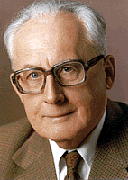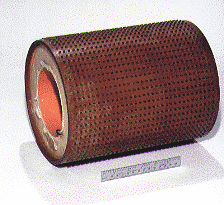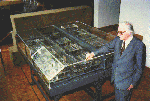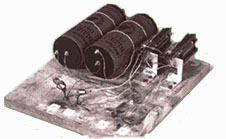click on the home button to go to the thocp home page
|
the Pre Industrial Era 1927-1937 Between 1935 and 1940, the German scientist
Konrad Zuse, worked in Berlin doing advanced research on using electric
relays as ON/OFF controls that could act as a BINARY (0 and 1) counter
mechanism. In 1941, he built the first computer that used the binary
(DIGITAL) process using electrical relays, and also built the first
vacuum tube digital computer system.
|
pre history | antiquity
| pre industrial era | industrial
era
1886 -
1900 - 1927
- 1938 - 1940 - 1944
| Related Articles |
| Related Resources |
![]() H.J.
Zeeman (the Netherlands) discovered that silicon
acts like a metal. Later, in 1930, it will be discovered
that Silicon is a semi conductor. Silicon formed the basis of all chips (1954)
to come deep into the 21st century.
H.J.
Zeeman (the Netherlands) discovered that silicon
acts like a metal. Later, in 1930, it will be discovered
that Silicon is a semi conductor. Silicon formed the basis of all chips (1954)
to come deep into the 21st century.
![]() Remington Typewriter
and Rand Kardex merged into Remington Rand.
Remington Typewriter
and Rand Kardex merged into Remington Rand.
![]() Fritz
Pleumer (Germany) patented his magnetic tape. Data could be recorded and
read back. The invention was based on that of Valdemar
Poulsen who invented the magnetic wire in 1898.
Fritz
Pleumer (Germany) patented his magnetic tape. Data could be recorded and
read back. The invention was based on that of Valdemar
Poulsen who invented the magnetic wire in 1898.

![]() The
punched card with 45 holes was replaced by one with 80 holes. The 45 holes were
regarded as limiting and changing it to 80 holes made the punched card one of
the most important data carriers until the 1990's. Because IBM, as the most
important manufacturer of computing devices and peripherals marked the 80 columns
card as a standard it rapidly became the industry standard.
The
punched card with 45 holes was replaced by one with 80 holes. The 45 holes were
regarded as limiting and changing it to 80 holes made the punched card one of
the most important data carriers until the 1990's. Because IBM, as the most
important manufacturer of computing devices and peripherals marked the 80 columns
card as a standard it rapidly became the industry standard.

 First
form of fax machine patented by Rudolf
Hell, a German engineer who pioneered in sending messages over long distances.
The machine was called the "Hell Schreiber"
First
form of fax machine patented by Rudolf
Hell, a German engineer who pioneered in sending messages over long distances.
The machine was called the "Hell Schreiber"
The Hellschreiber used the transmitted pulses to write images of characters directly on paper tape. Thus, Hell writing could be considered as a simple form of facsimile, covering seven image lines per character, with seven elements per line.

![]() Vanevar
Bush, of MIT (USA) developed the Analytical Difference Engine. His machine was
based on the analogue movements of segmented parts of calculating and ordinary
gears. It was the most accurate calculating machine made in this time.
Vanevar
Bush, of MIT (USA) developed the Analytical Difference Engine. His machine was
based on the analogue movements of segmented parts of calculating and ordinary
gears. It was the most accurate calculating machine made in this time.
![]() John Bernard Gudden discovered
that Silicon in pure form worked as an insulator, but the pure material behaved
as a metallic conductor. That he discovered the principle of a transistor with
this discovery he did not realize.
John Bernard Gudden discovered
that Silicon in pure form worked as an insulator, but the pure material behaved
as a metallic conductor. That he discovered the principle of a transistor with
this discovery he did not realize.
But scientists of the Bell laboratories soon realized that one could create
tracks of impurities in pure crystaline material. By doing that one created
a kind of "corridor" for electrons to travel by.
The principle to introduce impurities was called "doping". And this
was done by shooting with an electron canon on the silicon crystal or another
carrier.
![]() A Hungarian
scientist, Tihamer Nemes, filed a patent application in Germany for the principle
of making an optoelectrical system automatically transcribe speech. His idea
was to use the optical sound track on a movie film as a grating to produce diffraction
patterns (corresponding to speech spectra), which then could be identified and
typed out. The application was turned down as “unrealistic.” Since
then the problem of automatic speech recognition has occupied the minds of scientists
and engineers, both amateur and professional.(6)
A Hungarian
scientist, Tihamer Nemes, filed a patent application in Germany for the principle
of making an optoelectrical system automatically transcribe speech. His idea
was to use the optical sound track on a movie film as a grating to produce diffraction
patterns (corresponding to speech spectra), which then could be identified and
typed out. The application was turned down as “unrealistic.” Since
then the problem of automatic speech recognition has occupied the minds of scientists
and engineers, both amateur and professional.(6)
![]() E.
Wynn-Williams, at Cambridge, England, constructed a binary digital counter by
using thyratron tubes and used that principle in connection with a physics experiments.(14)
E.
Wynn-Williams, at Cambridge, England, constructed a binary digital counter by
using thyratron tubes and used that principle in connection with a physics experiments.(14)
![]() On
14 December 1931, Alan Blumlein applied for his famous patent, No.394,325, Binaural
Sound, in which he described in great detail, an electronic method of reproducing
sound from two microphones and two loudspeakers. He called this system 'Binaural'
from the human factor of having two ears by which we hear sound.
On
14 December 1931, Alan Blumlein applied for his famous patent, No.394,325, Binaural
Sound, in which he described in great detail, an electronic method of reproducing
sound from two microphones and two loudspeakers. He called this system 'Binaural'
from the human factor of having two ears by which we hear sound.
Because this patent was so far ahead of its time, it needed another 20 years
before it was fully appreciated, long after Blumlein's tragic early death in
1942. Of course, today, we know Binaural as 'Stereo'. After 70 years his ideas
for 'surround' sound were rediscovered and put to use in movies, theatres and
computer gaming.
 |
G. Taushek (Austria) invents on the basis of a principle discovered by Pleumer: the magnetic drum. He put a ferromagnetic layer on the outside of a metal drum.
Read and write heads were mounted in a distance of some micrometers that
produced an electro magnetic pulse. This pulse could be stored by changing
the magnetic orientation of the ferro magnetic particle the write head
passed over at that very moment. Each track had its own read and write head. |
![]() Quantum theory
of solids developed. This theory provides insight into the mechanical theory
of the structure, cohesion, and static and dynamic processes in solids, particularly
crystalline solids such as Silicon. The basic material of the chip.
Quantum theory
of solids developed. This theory provides insight into the mechanical theory
of the structure, cohesion, and static and dynamic processes in solids, particularly
crystalline solids such as Silicon. The basic material of the chip.
![]() EMI engineers
W F Tedham and J D McGee turned Campbell Swinton's (see 1908)
dream into reality by producing the first electronic picture pick-up tube in
secret experiments, contrary to the orders of their bosses at EMI. They displayed
their images on a cathode ray tube.(21)
EMI engineers
W F Tedham and J D McGee turned Campbell Swinton's (see 1908)
dream into reality by producing the first electronic picture pick-up tube in
secret experiments, contrary to the orders of their bosses at EMI. They displayed
their images on a cathode ray tube.(21)
![]() On the Moore School of Electrical
Engineering of the University of Pennsylvania an electronic differential-analyzer
was constructed.
On the Moore School of Electrical
Engineering of the University of Pennsylvania an electronic differential-analyzer
was constructed.
![]() The first fax
transmission via a telephone line took place. The transmission of a photo
from California to New York (NY) took about 30 minutes!
The first fax
transmission via a telephone line took place. The transmission of a photo
from California to New York (NY) took about 30 minutes!
![]() International
Business Machines introduced the "IBM 601",
a punch card machine with an arithmetic unit based on relays. Capable of doing
a multiplication in 1 second. The machine became important both in scientific
and commercial computation, and about 1500 of them will eventually be made.(15)
International
Business Machines introduced the "IBM 601",
a punch card machine with an arithmetic unit based on relays. Capable of doing
a multiplication in 1 second. The machine became important both in scientific
and commercial computation, and about 1500 of them will eventually be made.(15)

![]() Konrad
Zuse (Germany) started to construct the Z1, world's
first programmable computer, in his bedroom. This machine became so large that
it occupied his parent's living room as well. Shown here is a reconstruction
and the inventor is standing next to it at the Deutsches Museum in Munchen,
Germany
Konrad
Zuse (Germany) started to construct the Z1, world's
first programmable computer, in his bedroom. This machine became so large that
it occupied his parent's living room as well. Shown here is a reconstruction
and the inventor is standing next to it at the Deutsches Museum in Munchen,
Germany
Financing the project was not simple. Zuse's retired father went back to work
at the postal services and friends donated money. At some time the machine worked.
And thanks to a demonstration on an aviation show Zuse got support from the
government and could establish a workshop to continue to develop more sophisticated
models.
![]() Alan
M. Turing (UK 1912-1954) published his article: 'On Computable Numbers'.
Here Turing explained his ideas on the 'Universal
Turing Machine', an electronic calculator. A machine that could make any
calculation or logical operation. His model is theoretical and geared towards
solving mathematical problems. A working model will not be made. But his
ideas will determine the internal architecture of computers in the future.
Alan
M. Turing (UK 1912-1954) published his article: 'On Computable Numbers'.
Here Turing explained his ideas on the 'Universal
Turing Machine', an electronic calculator. A machine that could make any
calculation or logical operation. His model is theoretical and geared towards
solving mathematical problems. A working model will not be made. But his
ideas will determine the internal architecture of computers in the future.
![]() IBM sells its
first electrical typewriter. This earned them a market share of over 80% in
the next few years.
IBM sells its
first electrical typewriter. This earned them a market share of over 80% in
the next few years.
![]() The American
psychologist Benjamin Burack from Chicago (USA) develops what is probably the
first electrical Logic Machine: the Syllogism Machine. (7)
Burack's device uses light bulbs to display the logical relationships in a set
of propositions, but for some reason he didn't publish anything about his work
until 1949. (8) The machine belongs now to the national collections
of the Smithsonian Institute in Washington, USA.
The American
psychologist Benjamin Burack from Chicago (USA) develops what is probably the
first electrical Logic Machine: the Syllogism Machine. (7)
Burack's device uses light bulbs to display the logical relationships in a set
of propositions, but for some reason he didn't publish anything about his work
until 1949. (8) The machine belongs now to the national collections
of the Smithsonian Institute in Washington, USA.
![]() Claude
E. Shannon (USA 1916-? ) writes his master's thesis on machine logic.
It will take a separate article in 1938 to get his idea across, but then it
becomes fully recognized as a giant step in computer science.
Claude
E. Shannon (USA 1916-? ) writes his master's thesis on machine logic.
It will take a separate article in 1938 to get his idea across, but then it
becomes fully recognized as a giant step in computer science.
Shannon realizes in his paper that an electric circuit used the same concept
as Boolean Algebra. If an electric circuit is designed according to Boolean
rules, it can be used to represent logic. Expressions can be validated and calculations
be made.
It became clear that information could be manipulated by a machine. Shannon’s
publication had a tremendous effect and marked a turning point in the development
of modern computer science.(16)
![]() Howard
Aiken (USA) graduated at Harvard in physics and developed plans for a machine
that executed commands step by step. He approached James
W. Brice of IBM to discuss 'automatic calculators to calculate physic problems'.
Howard
Aiken (USA) graduated at Harvard in physics and developed plans for a machine
that executed commands step by step. He approached James
W. Brice of IBM to discuss 'automatic calculators to calculate physic problems'.
Mid 1939 the discussions were finalized and the building and design subcontracted
to Clair D. Lake and a group of engineers of the Endicott
laboratories. That is how the Automatic
Sequence Controlled Calculator (ASCC) a.k.a. Harvard
MARKI came into existence.
 (9)
(9)
tape reader mechanism of the ASCC
Instructions are fed into the machine on a paper tape (see above), cards, or
by setting switches. The numbers on which the instructions are to operate are
stored in registers. The Mark I is an electromechanical machine.
Its basic operations are performed by mechanical parts which are controlled
electrically by about 3,000 relays.
Although obsolete by the time it went into operation at Harvard in 1944, Mark
I operates for more than 15 years and produces valuable mathematical tables.
Aiken, who was familiar with the work of Babbage once remarked, "If Babbage
had lived seventy-five years later, I would have been out of my job."
While Mark I is solving U. S. Navy math problems, plans are underway for a machine
that is going to make the breakthrough from automatic to electronic processing
of data.

![]() George
Stibitz (c.1910-) of the Bell Telephone Laboratories (Bell Labs), New York City,
constructs a demonstration 1-bit binary adder using relays. This is one of the
first binary computers, although at this stage - see picture at left - it s
only a demonstration device. Improvements continued and are leading to the 'complex
number calculator' of Jan. 1940.(15)
George
Stibitz (c.1910-) of the Bell Telephone Laboratories (Bell Labs), New York City,
constructs a demonstration 1-bit binary adder using relays. This is one of the
first binary computers, although at this stage - see picture at left - it s
only a demonstration device. Improvements continued and are leading to the 'complex
number calculator' of Jan. 1940.(15)
![]() Dr. John V. Atanasoff and his
assistant Clifford Berry begin to build the first electronic digital computer.
In 1942 it will be finished and named ABC. It is not programmable but it provides
the foundation for the next advances in computers.(17)
Dr. John V. Atanasoff and his
assistant Clifford Berry begin to build the first electronic digital computer.
In 1942 it will be finished and named ABC. It is not programmable but it provides
the foundation for the next advances in computers.(17)
![]() While not using
the practical technology of the era, Alan Turing developed the idea of a "Universal
Machine" capable of executing any describable algorithm, and forming the basis
for the concept of "computability". Perhaps more importantly Turing's ideas
differed from those of others who were solving arithmetic problems by introducing
the concept of "symbol processing".
While not using
the practical technology of the era, Alan Turing developed the idea of a "Universal
Machine" capable of executing any describable algorithm, and forming the basis
for the concept of "computability". Perhaps more importantly Turing's ideas
differed from those of others who were solving arithmetic problems by introducing
the concept of "symbol processing".
![]()
| Last Updated on 4 October, 2004 | For suggestions please mail the editors |
Notes & References